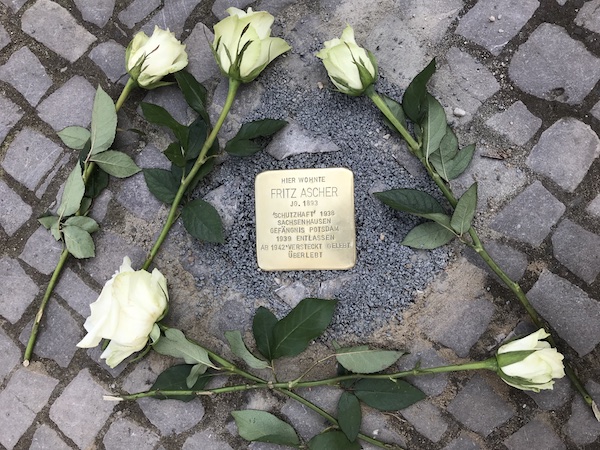Rachel Stern2018-12-04T11:47:15-05:00March 23rd, 2018|Newsletter|
Dear Friends, I was touched by how many neighbors and friends from near and far came out into the chilly but sunny winter weather on February 21 to celebrate Fritz Ascher and recognize his persecution by the National Socialists by laying a “Stolperstein” (stumbling stone) at Niklasstraße 21/23 in Berlin-Zehlendorf, where his family lived from 1909. Thank you to the anonymous donor for making this event possible, to Dirk Jordan (AG Stolpersteine), Michael Rohrmann (Projekt Stolpersteine) and Wolfgang Ellerbrock for organizing it, to Cornelie von Bismarck for creating a beautiful context, and to Sabine Witt from Museum Charlottenburg-Wilmersdorf in Berlin and Jutta Götzmann from Potsdam Museum for supporting it. A special thank you to the students from Potsdam for reciting [...]
Rachel Stern2018-12-04T12:07:01-05:00December 25th, 2017|Select Press Coverage|
Ein Zerrissener Das Potsdam Museum entdeckt Fritz Ascher, der sich in Potsdam vor den Nazis versteckte by Lena Schneider Wer war Fritz Ascher? Das Potsdam Museum hat diesem Unbekannten eine Sonderausstellung gewidmet. „Leben ist glühn“ heißt sie. Ein Bild, das hier hängt, kann man als bestürzende Antwort auf die Frage lesen. „Bajazzo“ heißt es, nach dem italienischen Bruder des Harlekin. Zu sehen ist eine schemenhafte Gestalt, in gelbem Kostüm. Im weiß geschminkten Gesicht ist so etwas wie ein trostloser Schatten des Clownsgenres auszumachen: schwarze Augen, die rot überzogen Mundwinkel krümmen sich nach unten. Das ganze Bild ist wie zerschossen von Farbpunkten. Die Antwort darauf, wer Fritz Ascher, geboren 1893 als Kind jüdischer Eltern, war, findet sich im Entstehungsdatum des Bildes: [...]
Rachel Stern2018-12-13T19:05:14-05:00December 22nd, 2017|Exhibitions, Past Exhibitions|
Stiftung Gedenkstätte Lindenstrasse in Potsdam examines for the first time the history of the Potsdam police prison, the prison where Fritz Ascher spent almost 5 months in 1939. When the prison building in what is today Henning-von-Tresckow-Strasse was torn down in 2002, Potsdam historian Hannes Wittenberg was able to save two original artefacts, both today in the collection of the Potsdam Museum: an original prison door and a model of the prison building built by prisoners in the 1980s for fire protection exercises. Both objects are on display in the exhibition, together with original photographs and documents of the prison building. Fritz Ascher is one of the former prisoners, whose biography is being told. (website link) Questions being asked in [...]
Rachel Stern2018-12-04T12:14:23-05:00December 22nd, 2017|Newsletter|
Dear Friends, I am humbled and honored to have received the Lea and Hans Grundig Prize for my work about Fritz Ascher. Right on time for his 125th birthday, the Fritz Ascher retrospective is now open in Berlin and Potsdam, the two places where the artist lived and worked. Museum Charlottenburg-Wilmersdorf in der Villa Oppenheim in Berlin exhibits an overview of the artist’s creative development, with a focus on works that relate to Berlin. We see his sketch of the artist Max Liebermann as well as his love for music and performance in Weimar Republic paintings like “Beethoven” and “Bajazzo and Artists”. After surviving the Nazi terror regime in hiding in the Berlin Grunewald neighborhood, he painted these works over [...]
Rachel Stern2018-12-04T12:21:16-05:00October 25th, 2017|Select Press Coverage|
Bilder eines Vereinsamten Das Museum Gunzenhauser erinnert an den kaum bekannten jüdischen Künstler Fritz Ascher: Dessen expressionistisch-symbolistische Bilder sind eine echte Wiederentdeckung wert, denn zwei Weltkriege konnten seine künstlerische Kraft nur schwächen - aber nicht brechen Matthias Zwarg CHEMNITZ - Es gibt ein Porträt von Fritz Ascher aus dem Jahr 1912, gemalt von seinem Freund Eduard Bischoff. Es zeigt einen optimistischen jungen Mann: Anzug, rote Krawatte, frech den Kopf auf den Arm gestützt, lächelt er froh und selbstbewusst dem Betrachter entgegen. Und es gibt ein Selbstporträt von Fritz Ascher aus dem Jahr 1953: Weiss und grau über schwarzer Tusche, Aquarell-Farbtupfer wie Wunden in dem Gesicht, in das so etwas wie die Suche nach Fassung nach dem Entsetzen eingeschrieben ist. Dazwischen [...]







